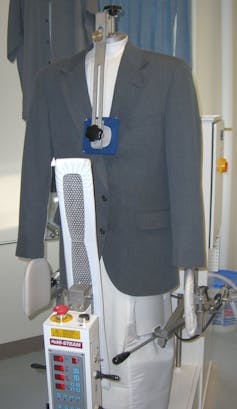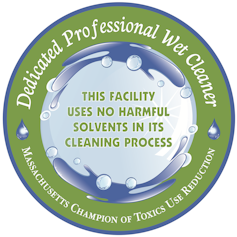What is 'green' dry cleaning? A toxics expert explains
- Written by Joy Onasch, Business & Industry Program Manager, Toxics Use Reduction Institute, University of Massachusetts Lowell
The winter holidays are a busy time for many businesses, including retail stores, grocers, liquor stores – and dry cleaners. People pull out special-occasion clothes made of silk, satin or other fabrics that don’t launder well in soap and water. Then there are all those specialty items, from stained tablecloths to ugly holiday sweaters[1].
Few consumers know much about what happens to their goods once they hand them across the dry cleaner’s counter. In fact, dry cleaning isn’t dry at all. Most facilities soak items in a chemical called perchloroethylene[2], or perc for short.
Exposure to perc is associated with a variety of adverse human health effects[3]. The International Agency for Research on Cancer, a unit of the World Health Organization, has designated perc as a probable human carcinogen[4]. The most direct risk is to dry-cleaning workers, who may inhale perc vapors or spill it on their skin[5] while handling clothes or cleaning equipment.
At the Toxics Use Reduction Institute[6] at UMass Lowell, we work with small businesses and industries to find ways they can reduce the use of toxic materials and find more benign substitutes. For over a decade the Toxics Use Reduction Institute has worked with dry cleaners to help them move to a safer process called professional wet cleaning[7], which uses water and biodegradeable detergents. This is a clear trend nationwide: In a 2014 industry survey, 80 percent of respondents said they used professional wet cleaning for at least 20 percent of their plant’s volume[8].
Joon Han, owner of AB Cleaners in Westwood, Massachusetts, demonstrates wet cleaning technology and explains why he decided to stop using perc.Perc’s long history
Perc has been the standard dry cleaning solvent for over 50 years because it is effective, easy to use and relatively inexpensive. But improper use, storage and disposal of perc have resulted in widespread soil and groundwater contamination[9] at dry cleaning sites. Studies show that long-term exposure can harm the liver, kidneys, central nervous system and reproductive system[10] and may harm unborn children.
According to a widely cited estimate from federal agencies, there are about 36,000 professional garment care facilities in the United States, and about 85 percent of them use perc[11] as their main cleaning solvent. Industry surveys in 2009[12] and 2012[13] indicate that that figure has fallen to between 50 and 70 percent.
 Tensioning equipment, such as this form finisher, is used to shape clothes after the washing and drying process.
TURI, CC BY-ND[14]
Tensioning equipment, such as this form finisher, is used to shape clothes after the washing and drying process.
TURI, CC BY-ND[14]
EPA has identified perc as a high priority chemical[15]. Under amendments to the Toxic Substances Control Act adopted in 2016, the agency has a mandate to study the health and environmental effects of perc and other priority chemicals, and potentially take action to reduce risk from exposure to them[16]. However, in June 2018, EPA announced it was adopting a new approach to chemical risk screening that could exclude consideration of many sources of exposure[17], including exposure to perc contamination in drinking water.
Safer alternatives
It could be a regrettable substitution[18] for dry cleaners to switch to other solvents if those substances also pose potential or unknown health and environmental risks. Accordingly, in 2012 the Toxics Use Reduction Institute evaluated a half-dozen alternative solvents[19], along with professional wet cleaning.
Overall, we found that the alternative solvents exhibited less persistence in the environment, potential to accumulate in the human body or the environment, or toxicity to aquatic life than perc. Most also appeared to be safer overall to human health. However, toxicological data were lacking for some of them, so future analyses may find that they are less benign than currently thought.
Some of these alternatives are combustible, so using them would require cleaners to buy specialized equipment to protect against fires or explosions. On the other hand, professional wet cleaning is water-based and poses no such risks. It uses computer-controlled washers and dryers, along with biodegradable detergents and specialized finishing equipment, to process delicate garments that would otherwise be dry cleaned.
We suggest that dry cleaners who want a safer alternative to perc should consider the key environmental and human health criteria, and then think about financial and technical issues at their own facilities to find the best alternative for them. Anecdotal information in Massachusetts indicates that cleaners are switching to petroleum-based alternatives such as DF2000™[20] at a higher rate than wet cleaning, and to other solvent alternatives at about the same rate as wet cleaning. Some operators doubt that a wet cleaning process can clean as well as solvent cleaning[21], but the Toxics Use Reduction Institute is working to dispel that myth through case study analysis, grants, demonstrations and training events.
 Logo for Massachusetts cleaners that have adopted professional wet cleaning.
TURI, CC BY-ND[22]
Logo for Massachusetts cleaners that have adopted professional wet cleaning.
TURI, CC BY-ND[22]
Making the switch
When the Toxics Use Reduction Institute began working with dry cleaners on this issue in 2008, to our knowledge there were no dedicated wet cleaners operating in Massachusetts. Today the state has over 20 dedicated wet cleaners[23]. Other cleaners seeking options for moving away from perc can obtain data from the Toxics Use Reduction Institute[24] and other researchers[25] to help them make informed decisions about equipment purchasing and staff training.
At the Toxics Use Reduction Institute we also work with many other sectors to help steer them away from harmful chemicals and towards safer alternatives. Examples include removing flame retardants from foam pit cubes at gymnastics training facilities[26]; helping companies develop cleaning products[27] without harsh solvents and acids; and researching and reformulating alternatives to methylene chloride for paint stripping[28].
In each case, the goal is to identify safer alternatives and then find champions of change who are willing to make the switch and show their peers how to get good results without using harmful chemicals. This model has shown that industry and consumer choices can push change from the bottom up.
References
- ^ ugly holiday sweaters (people.com)
- ^ a chemical called perchloroethylene (en.wikipedia.org)
- ^ a variety of adverse human health effects (www.turi.org)
- ^ a probable human carcinogen (monographs.iarc.fr)
- ^ inhale perc vapors or spill it on their skin (www.osha.gov)
- ^ Toxics Use Reduction Institute (www.turi.org)
- ^ professional wet cleaning (www.turi.org)
- ^ at least 20 percent of their plant’s volume (americandrycleaner.com)
- ^ widespread soil and groundwater contamination (drycleancoalition.org)
- ^ liver, kidneys, central nervous system and reproductive system (www.atsdr.cdc.gov)
- ^ about 85 percent of them use perc (www.cdc.gov)
- ^ 2009 (americandrycleaner.com)
- ^ 2012 (americandrycleaner.com)
- ^ CC BY-ND (creativecommons.org)
- ^ high priority chemical (www.epa.gov)
- ^ reduce risk from exposure to them (www.epa.gov)
- ^ exclude consideration of many sources of exposure (www.nytimes.com)
- ^ regrettable substitution (www.edf.org)
- ^ evaluated a half-dozen alternative solvents (www.turi.org)
- ^ DF2000™ (www.exxonmobilchemical.com)
- ^ a wet cleaning process can clean as well as solvent cleaning (www.rit.edu)
- ^ CC BY-ND (creativecommons.org)
- ^ dedicated wet cleaners (www.turi.org)
- ^ Toxics Use Reduction Institute (www.neha.org)
- ^ other researchers (www.ncbi.nlm.nih.gov)
- ^ gymnastics training facilities (www.turi.org)
- ^ cleaning products (www.turi.org)
- ^ alternatives to methylene chloride for paint stripping (www.cbsnews.com)
Authors: Joy Onasch, Business & Industry Program Manager, Toxics Use Reduction Institute, University of Massachusetts Lowell
Read more http://theconversation.com/what-is-green-dry-cleaning-a-toxics-expert-explains-99830

